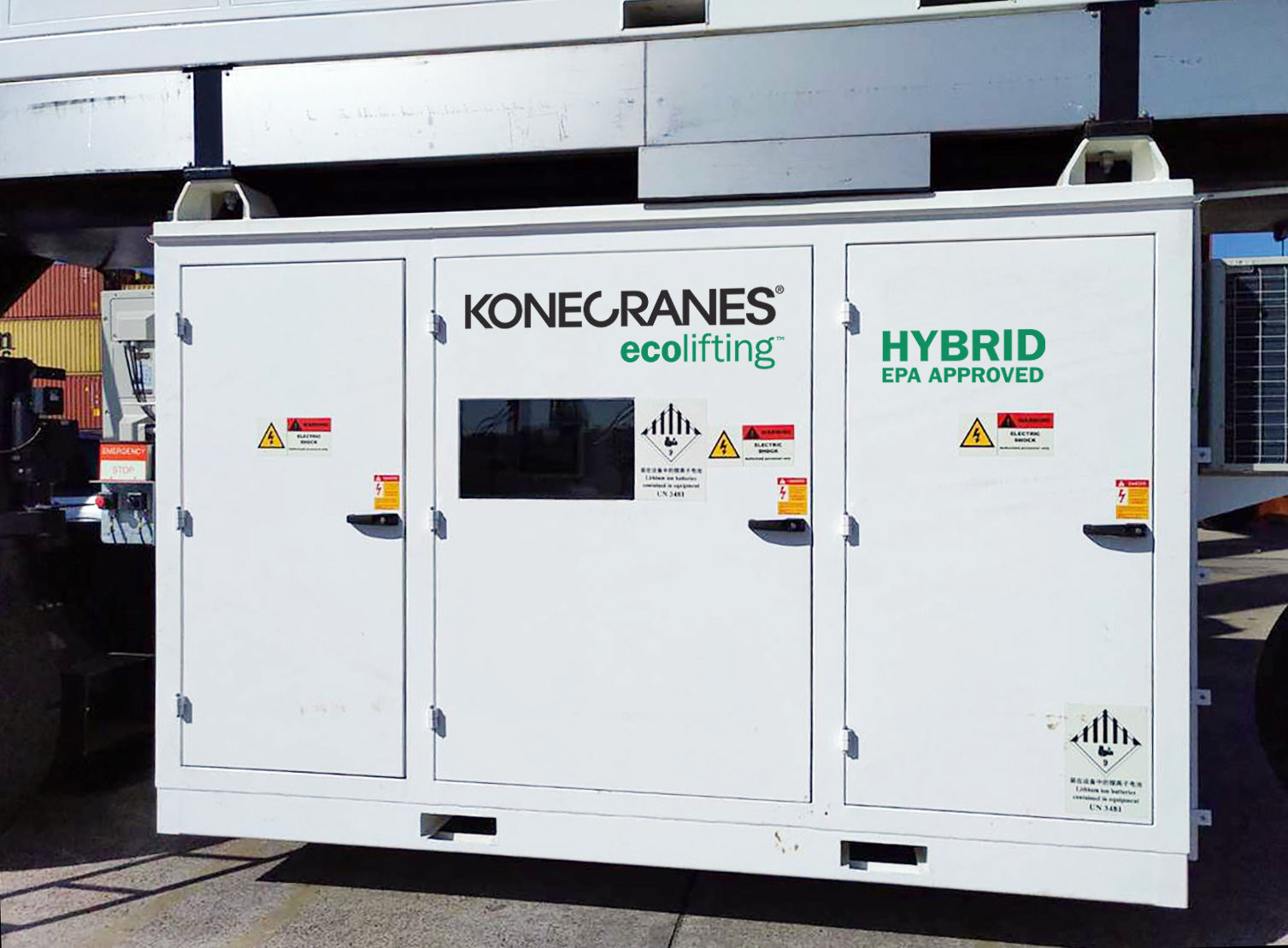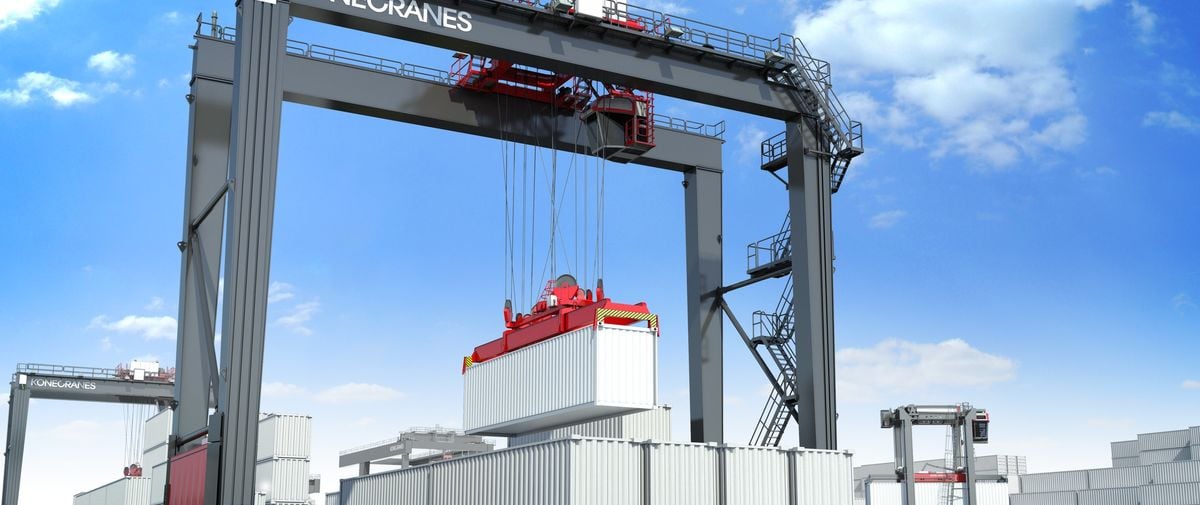Lifting in today's container handling industry demands high-quality equipment that minimizes carbon emissions without sacrificing performance. Converting diesel-electric Rubber-Tired Gantry (RTG) cranes to hybrid via retrofitting can be both economical and sustainable.
America's Environmental Protection Agency (EPA) has approved Konecranes RTG hybrid technology, so container terminals across the United States can retrofit their existing Konecranes RTGs and receive a Diesel Emissions Reduction Act (DERA) grant to assist with the cost - a minimal investment for maximum benefit to both their business and the environment.
This article introduces you to the Konecranes RTG hybrid retrofit, takes you through the process of EPA approval, and how you too can get DERA funding.
Hybrids bring the best of both worlds
Using the same basic engineering principles as a hybrid car, Konecranes combined an electric motor with a diesel engine and launched its hybrid RTG in December 2019. Realizing that there was a need to bring existing diesel RTGs up to date, Konecranes has also developed a retrofit power pack as a turnkey solution, using the same eco-efficient technology to convert existing diesel-electric machines into hybrids.
The hybrid retrofit power pack adds a battery and replaces the diesel engine with a smaller diesel generator (genset). During normal use, the genset generates electricity for storage in the battery, and the crane operates only under battery power. But when you need peak power, the genset and battery can work in parallel. This ensures that the RTG always runs with the best energy efficiency. Operators can switch stacks easily, as no uncoupling is required. Braking energy is fed back to top up the battery charge. And if the battery is not available for some reason, the genset can act as an emergency backup power source.
Your hybrid RTG is a high-utilization machine, designed for 91,000 moves per year. Regulated to Tier 4, the generator runs for about one-third of its operating time. It doesn't have to stop to charge, but will keep working automatically, invisible unless your operators take a look at it on the control panel through the Battery Monitoring System (BMS). The hybrid modules are completely integrated into the Konecranes RTG systems, including the PLC crane control, CMS monitoring, and TRUCONNECT® Remote Monitoring.
Offering the same performance as a diesel RTG, hybrid conversion brings a raft of benefits, at the core of which are longer uptime, lower maintenance and running costs, and greatly increased eco-efficiency with less fuel, reduced carbon emissions, and much less noise.
But how did we get EPA approval?
Putting it on the line
 We had a considerable amount of data about the hybrid Konecranes RTG from customer operations. It showed reductions of 60% in fuel consumption, 75% in maintenance time, 80% in oil consumption, and 60% in carbon dioxide (CO2).
We had a considerable amount of data about the hybrid Konecranes RTG from customer operations. It showed reductions of 60% in fuel consumption, 75% in maintenance time, 80% in oil consumption, and 60% in carbon dioxide (CO2).
But for the EPA to approve, we had to establish proof of concept by testing in a real-world operating environment by a local independent third party.
We provided a standard Tier 3 diesel-electric RTG and two hybrid RTGs for testing and comparison by West Virginia University (WVU) at a terminal owned by the South Carolina Port Authority (SCPA), a long-time Konecranes customer interested in the hybrid technology if approval came through.
Standard use cycling and extended idling were examined with the same spreader, container and starting conditions using Portable Emission Measurement Systems (PEMS) for a wide range of results.
After a full data analysis, the EPA issued an approval certificate showing that, compared to the Tier 3 machine, the Konecranes hybrid RTGs achieved reductions of 90% in particulate matter, carbon monoxide (CO), hydrocarbons, and oxide of nitrogen. The CO2 reduction was approved to 30%, but it often shows 60% reduction and showed a peak of 63% during WVU testing.
The entire process took a total of 8 months, with 6 months of planning and preparation from July to December 2020, followed by 2 months of on-site testing completed in February 2021, and final approval for our hybrid RTG technology in April.
Approval means that you can get DERA funding to subsidize the cost of your hybrid RTGs and hybrid retrofits from Konecranes.
DERA can help you
The Diesel Emissions Reduction Act (DERA) was created as part of new energy laws in the United States in 2005. It allows the EPA to offer funding to accelerate the upgrade and turnover of legacy diesel equipment. You can apply at the national or state level - or both - for an annual funding round to convert your diesel-electric Konecranes RTGs to hybrids.
You will be required to pay a minimum of 30% of the cost, and can get up to 60% through DERA, determined by the content of your application.
Every customer case is different, so Konecranes has prepared a DERA Grant Pack which details the forms you need to fill out when submitting an application. We can also provide you with a customer walkthrough, guiding you as you prepare your application.
Implications
Modern container ports are increasingly focused on finding sustainable ways to stay ahead of growing demand. A fully electric operation might be your long-term goal, but that requires a major infrastructure investment in money and time. The RTG hybrid retrofit is an exciting step on the path to Ecolifting for modern operators interested in reducing their carbon footprint and meeting strict emission requirements at reasonable cost, and the DERA subsidy reduces costs even further.
Not only are they economical, but Konecranes RTG hybrid retrofits are fast, with around 6 months from order to delivery, and only 2-3 weeks' work on-site to install, minimizing downtime and any disturbance to your current operations. They bring your old machines up to date with the latest available technology.
As their engineering improves, diesel engines will become even more fuel-efficient. Biodiesel is already on the market, and new fuels will reduce emissions to almost zero. With the trademark durability of Konecranes equipment, you'll be able to use your hybrid crane for many years after the hybrid retrofit, making it well worth the investment.
An RTG hybrid retrofit is easy, good value for money, and made to last.
Get the Grant Pack here
Contact Konecranes here.

 We had a considerable amount of data about the hybrid Konecranes RTG from customer operations. It showed reductions of 60% in fuel consumption, 75% in maintenance time, 80% in oil consumption, and 60% in carbon dioxide (CO2).
We had a considerable amount of data about the hybrid Konecranes RTG from customer operations. It showed reductions of 60% in fuel consumption, 75% in maintenance time, 80% in oil consumption, and 60% in carbon dioxide (CO2).